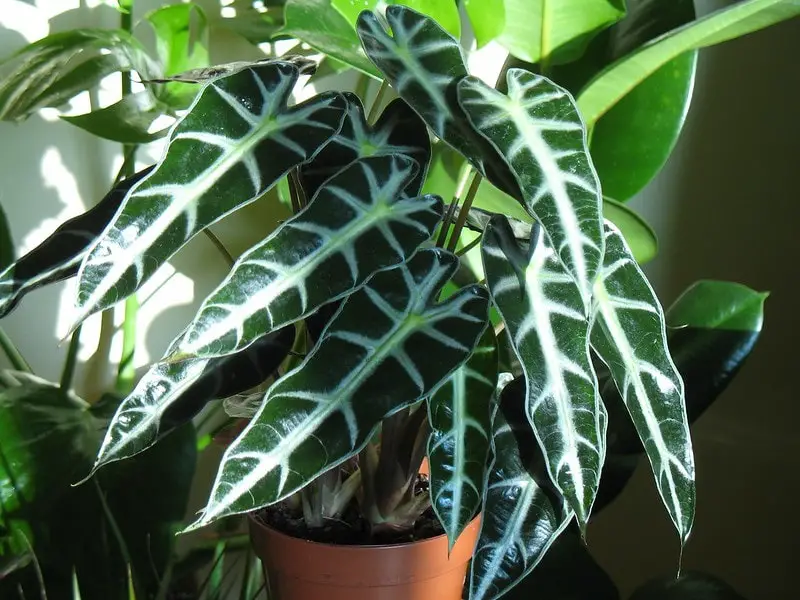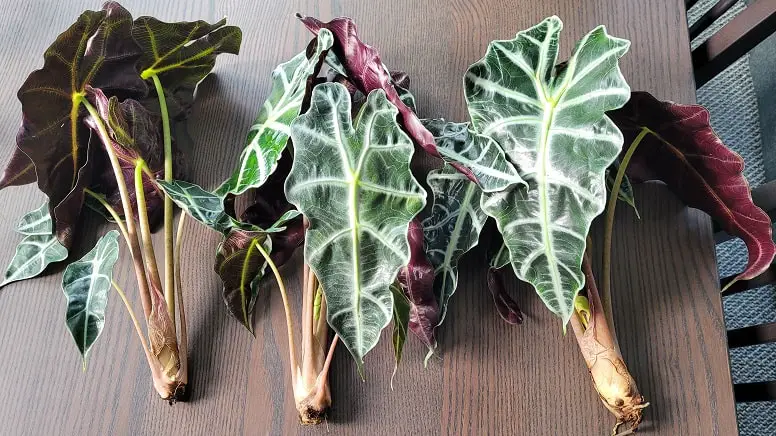Alocasia Amazonica (alocasia polly) is a hybrid plant of alocasia longiloba and sanderiana. The large arrowhead leaves with prominent veins are the reason behind its appreciation in many American homes.
Alocasia amazonica care involves the provision of bright indirect sunlight, average humidity, well-draining potting soil, and an indoor temperature range of 65-80oF. Feed the houseplant every two to four weeks during spring and summer.
Many houseplant enthusiasts tend to kill this alocasia Polly at home. It is an indoor plant that needs extra attention for successful growth. Continue reading this comprehensive guide to learn how to care for alocasia Polly (African Mask) like a professional.
You Might Also Like: How to Care for Alocasia Frydek

What Does Alocasia Amazonica Look Like?
Alocasia amazonica is a hybrid cultivation of alocasia longiloba and sanderiana. The hybrid plant hails from Southeast Asia and South America.
The alocasia Polly has large arrowhead leaves with a leathery appearance. The foliages have deep-green coloration with thick white or silver veins and wavy edges.
The alocasia leaves grow up to six inches long with ultimate care. Besides that, the houseplant can reach 1-2 feet tall and wide. The alocasia species can tolerate warm conditions.
An indoor Amazonian elephant ear does not bloom. Many houseplant enthusiasts consider the alocasia species due to its vibrant foliages.
Be sure to keep the houseplant away from cats, dogs, and toddlers. It contains calcium oxalate compounds that are toxic to pets and humans if ingested.
You Might Also Like: How to Care for Sensitive Plant
Alocasia Amazonica Care Details
| Origin | Native to tropical Southeast Asia and South America. |
| Scientific Name | Alocasia x Amazonica |
| Common Names | African Mask Alocasia Polly Elephant Ear |
| Maximum Growth (Approx.) | 1-2 feet tall and wide. |
| Soil Requirements | Lightweight and well-draining. |
| Light Requirements | Bright indirect sunlight. Avoid direct sunlight due to the leaf scorching effect. |
| Temperature Range | 65-80oF (18-27oC). Temperature below 60oF triggers dormancy. |
| Watering Needs | Consistent moist soil during spring and summer. Reduce watering frequency in winter. |
| Humidity Requirements | Above 50%. But it can thrive under moderate to high humidity levels. |
| Feeding Program | Apply dilute the fertilizer to the plant every two to four weeks during the growing season. |
| Propagation | Rhizome division in springtime. |
| Bloom Time | Spring and summer though rare. |
| Flower color | Green |
| Repotting | Once every 2-3 years. |
| Toxicity | Poisonous to pets and humans. |
How to Care for Alocasia Amazonica Plant
Alocasia Amazonica Soil Requirements
Lightweight and well-draining potting soil are the best for growing alocasia amazonica. The soil condition will result in the best performance and healthiest houseplant.
Heavyweight potting mediums tend to hold more moisture to cause root rot problems and even plant death. I recommend the use of Jungle Mix for growing alocasia amazonica.
Jungle mix is readily available in many plant stores online. Use one of these potting soils from the Amazon store. These potting soils are ideal for all aroid houseplants.
The best alternative is to create your soil mixture at home. I recommend mixing fir bark, perlite, coco coir, horticulture charcoal, and worm castings in the right proportion.
Alocasia Amazonica Light Requirements
Alocasia Polly needs bright indirect sunlight to maintain the deep-green coloration. The low light condition will make the houseplant stop growing and fade its color.
Direct sunlight exposure will burn the foliages. Besides that, the plant will become limp and droopy in the long run. The issue occurs due to rapid dehydration than water intake.
Place the houseplant in a location that receives medium to bright indirect sunlight. Early morning and late evening direct sunlight will not harm your houseplant.
Alocasia Amazonica Temperature Range
Indoor alocasia amazonica prefers a temperature range of 65-80oF. Any temperature below 55oF will make the plant stop growing and even cause foliage death.
But the underground bulbs will remain alive throughout the dormancy stage. The leaves will re-sprout when the temperature becomes warm in spring and summer.
Maintain a temperature range of 60-80oF to keep the houseplant happy and healthy. Use a digital thermometer (Check the Best Deals on Amazon) to detect indoor temperature changes.
How to Water Alocasia Amazonica
The Amazonian elephant ear loves to grow near water sources in its native habitat to keep the roots moist. I recommend watering the plant more often to keep the soil moist and not soggy.
Water the houseplant twice a week during spring and summer. But reduce the watering frequency in winter due to dormancy. Allow the soil to dry before watering.
A damp condition increases the risk of root rot problems and even plant death. Be sure to inspect soil moisture content before watering your favorite houseplant.
Insert your index finger in the topsoil about 2-3 inches to determine potting soil moisture. If the soil is dry, consider soaking it until water runs through the drainage holes.
Alocasia Amazonica Humidity Requirement
Alocasia amazonica needs a warm and humid environment to thrive well. Maintain moderate to high humidity levels to keep the foliages happy and healthy.
Replicating the rainforest humidity for alocasia Polly can be a daunting experience. Relocate the houseplant to the bathroom due to its high humidity requirements.
Another excellent option is to install a humidifier at home. The device will help to boost indoor humidity that mimics the plant’s native habitat.
Avoid misting the Amazonian elephant ear plant to reduce the risk of leaf spot and other fungal diseases. Either install a humidifier or keep the houseplant in the bathroom.
Alocasia Amazonica Fertilizer Needs
The African mask plant is not a heavy feeder like other tropical houseplants. But fertilizer application every 2-4 weeks during spring and summer fosters plant full potential.
Use a well-balanced liquid fertilizer rich in phosphorus and nitrogen. Remember to dilute the fertilizer before feeding your houseplant. Stop fertilizing the plant in winter due to dormancy.
Be sure to flush the potting mix every few months to avoid salt accumulation around the plant roots. Too much salt is toxic and might ruin the African mask plant’s health.
I recommend the use of homemade organic fertilizer over the artificial counterpart to reduce the risk of over-fertilization. Read my post on how to make homemade fertilizer for houseplants.
Pruning and Maintenance
Alocasia amazonica requires a minimal pruning routine. I recommend removing old or damaged foliages to redirect energy to new growths.
Use a sharp and sterilized blade (Check Best Deals on Amazon) to snip off a leaf. Use rubbing alcohol to disinfect the blade before removing the damaged leaves.
How to Repot Alocasia Amazonica
The African mask plant is less vulnerable to root-bound issues. There is no need for repotting unless it has overgrown the small pot or the potting mix is exhausted.
The best period to repot alocasia amazonica is in springtime. The season is when the houseplant is experiencing active growth.
Use a pot that is slightly bigger than the previous one with drainage holes at the bottom. Transplant the houseplant and fill it with well-draining potting soil.
Alocasia Amazonica Propagation
Alocasia Polly propagation is undertaken during springtime. Take the advantage of repotting the houseplant to avoid ruining it.
Pull the root away from the parent plant and identify as many roots as possible connecting to the offsets. Divide the offsets from the main plant.
Plant each offset in a container and provides ultimate care. Remember to water the plant more often and place it in an area with bright natural light.
How to Clean Alocasia Amazonica Leaves
Alocasia amazonica plant has large arrowhead leaves with prominent veins. Indoor dust at home might ruin the beauty of your houseplant.
Spray the foliages with lukewarm water to remove the dust. Besides that, spray the leaves with a mild soap solution to get rid of pests.
Clean leaves facilitate photosynthesis which keeps the plant healthy and happy. Avoid using shine products to clean the leaves since it might result in a waxy residue.

Common Problems and Solutions
Pests
Indoor African mask plants are vulnerable to spider mites. These tiny insects suck juices from the plant and lead to its death if not controlled.
Inspect the leaf’s undersides to identify the spider mites. Use either insecticidal soap or neem oil to eliminate the pests. I recommend Ecogarden Organic Pesticides (Check the Price on Amazon).
Diseases
Amazonian elephant ear is not plagued by many diseases. It does not imply that the species is invincible to houseplant diseases.
Root rot is the biggest threat to alocasia amazonica plants due to wet conditions. The houseplant does not tolerate a damp environment for an extended period.
If the leaves begin turning yellow or brown, inspect the soil moisture and repot to fresh potting soil. Trim the affected roots with a sterilized pruner before repotting.
Frequently Asked Questions
Why Is My Alocasia Amazonica Dying?
Improper soil moisture is the leading cause of the problem. Alocasia amazonica is not tolerant to drought and damp environments.
I recommend watering the potting soil more often without becoming soggy. A hydrated plant will stay happy and healthy throughout the year.
Is Alocasia Amazonica Toxic to Pets and Humans?
Yes. The plant contains calcium oxalate crystals that are highly toxic to cats, pets, and toddlers if ingested. It causes intense mouth burning that leads to airways swelling and death.
Seek immediate medical assistance from a professional. Remember to keep the houseplant away from pets and children.
Why Are My Alocasia Amazonica Leaves Drooping?
Droopy leaves on alocasia Polly occur due to improper watering routine. Other possible causes are pests, insufficient sunlight, and lack of nutrients in the soil.
Take the time to investigate the plant and identify the exact cause. Use the information to fix the problem affecting your houseplant.
Why Are My Alocasia Amazonica Leaves Turning Brown?
Over-fertilization and low humidity are the leading causes of brown leaves. Other potential causes are direct sunlight exposure and overwatering.
Investigate the houseplant to identify the exact cause. Implement proper alocasia amazonica care to fix the cause of the problem.
Why Are My Alocasia Amazonica Leaves Turning Yellow?
Root or stem rot due to overwatering is the major cause of yellow leaves. Under-fertilizing is the other possible cause of the problem.
I recommend repotting the houseplant from the wet potting soil to overcome root rot issues. Feed the plant two to four weeks during summer and spring.
Conclusion
Cultivation of alocasia amazonica at home is a no-brainer. The tropical plant can flourish indoors without becoming fussy under proper growing conditions.
How to care for the alocasia amazonica involves the provision of bright indirect sunlight, moderate soil moisture, high humidity, and a temperature range of 65-80oF.
Remember to feed the houseplant for two to four weeks during the spring and summer. It is the season when the plant experience active growth.
I hope the information in my comprehensive guide will help you grow and care for alocasia amazonica like an expert. Good luck.
You May Also Like:
